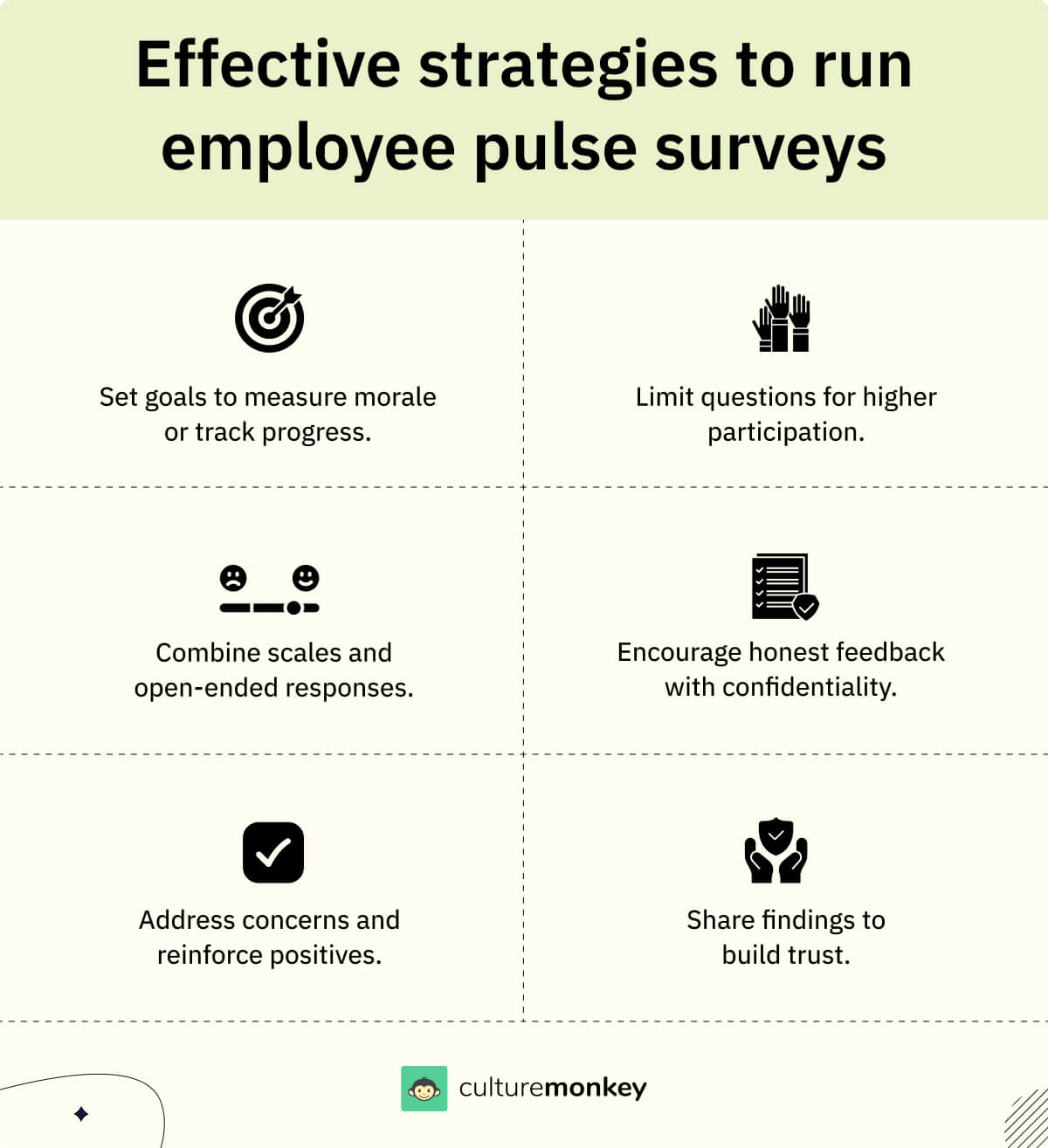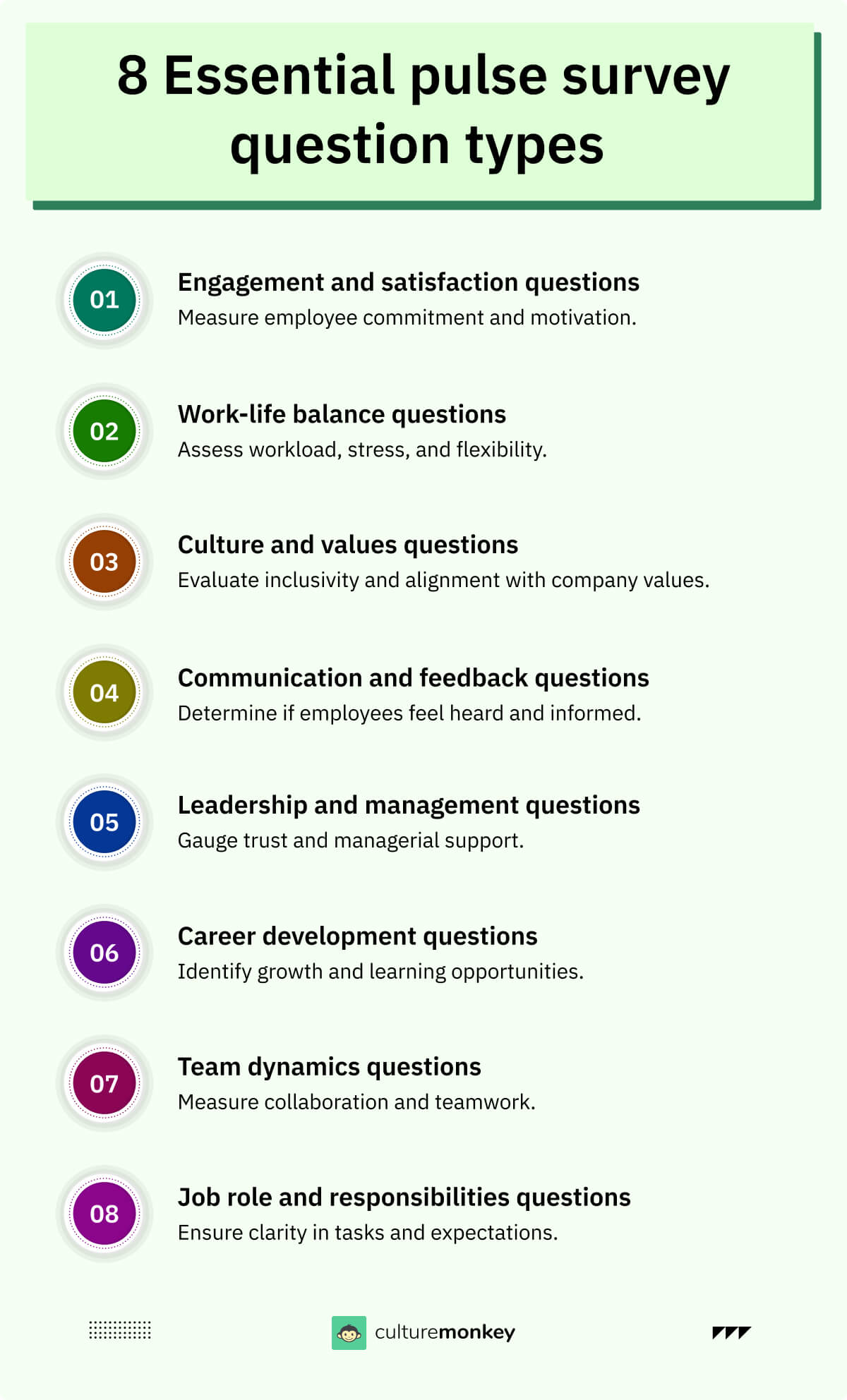What is workplace pulse: 50+ pulse check questions to ask your employees in 2025

In the evolving landscape of modern workplaces, the concept of a "workplace pulse" has emerged as a vital tool for organizations aiming to maintain a healthy and productive workforce.
The workplace pulse involves regular assessments of employee sentiments and well-being through survey results and periodic pulse checks. These short, frequent surveys offer insights into areas such as employee morale, job satisfaction, and the effectiveness of company policies.
As we navigate 2025, workplace pulse checks have become increasingly crucial, especially with the prevalence of hybrid and remote work. These pulse checks help employers stay attuned to their employees' experiences, enabling proactive issue resolution and fostering a culture of transparency and continuous improvement.
To maximize the benefits of workplace pulse checks, asking the right questions is essential. This blog explores over 50 pulse check questions tailored to capture the diverse experiences of today’s workforce, covering specific topics, like mental health, work-life balance, remote work challenges, and career development opportunities.
Blog Highlights


What is a workplace pulse?

A workplace pulse is a strategic approach employed by organizations to regularly assess and monitor the overall health and well-being of their workforce. It involves the use of short, frequent surveys known as pulse checks to gauge employee sentiments, attitudes, and experiences.
Unlike traditional annual surveys, workplace pulse checks are designed to be quick and easy to complete, allowing for real-time feedback and timely interventions.
The primary objective of a workplace pulse is to create a continuous feedback loop between employees and management. This ongoing dialogue helps organizations identify emerging issues, track changes in employee morale and annual engagement, and measure the impact of initiatives and policies.
By maintaining a finger on the pulse of the workplace, companies can respond swiftly to concerns, thereby enhancing employee satisfaction, engagement, and productivity.
In the contemporary work environment, characterized by rapid changes and increased flexibility, the importance of workplace most employee pulse surveys and checks has grown significantly and is more important than an annual engagement survey.
They provide invaluable insights into the dynamics of remote and hybrid work, mental health, work-life balance, and career development opportunities.
By regularly soliciting and acting on employee feedback, organizations can foster a culture of transparency, trust, and continuous improvement, ultimately leading to a more resilient and thriving workforce. The workplace pulse is, therefore, a critical tool for modern human resource management and organizational development.
What is a pulse check at work?

A pulse check at work is a streamlined, efficient method for organizations to gather regular feedback from employees about their experiences, feelings, and overall satisfaction.
Conducted through short, frequent surveys, pulse checks are designed to be quick and easy for employees to complete, ensuring high response rates, timely insights, and no survey fatigue.
The main purpose of a pulse check is to create a continuous flow of feedback between employees and management. This enables organizations to monitor and address issues as they arise, rather than waiting for annual surveys or formal reviews.
Pulse checks can cover a wide range of topics, such as job satisfaction, team dynamics, workplace culture, leadership effectiveness, and specific organizational changes or initiatives.
They offer a way to stay connected with employees, understand their evolving needs, and adapt to the changing dynamics of the workplace.
By regularly conducting employee pulse checks, organizations can proactively identify and address potential problems, support employee well-being, and foster a positive and engaging work culture.
Ultimately, pulse checks at work serve as a vital tool for maintaining a responsive and agile organization, capable of sustaining high levels of employee engagement and productivity.
Why use pulse surveys?

Pulse surveys are a powerful tool for organizations aiming to maintain a dynamic and responsive work environment. Here are several reasons why using pulse surveys is beneficial:
- Real-time feedback: Pulse surveys provide immediate insights into employee sentiments and attitudes. This real-time feedback allows organizations to address concerns promptly, preventing issues from escalating and fostering a proactive approach to employee management.
- High participation rates: Due to their brevity and frequency, pulse surveys are less burdensome for employees compared to lengthy annual surveys. This typically results in higher participation rates, ensuring a more comprehensive understanding of the workforce’s mood and opinions.
- Continuous improvement: Regularly gathering feedback enables organizations to monitor the effectiveness of their initiatives and policies. Pulse surveys create a continuous feedback loop, allowing for ongoing adjustments and improvements that align with employees’ evolving needs and expectations.
- Enhanced employee engagement: By consistently seeking and acting on employee feedback, organizations demonstrate that they value their employees’ opinions. This can significantly boost morale and engagement, as employees feel heard and appreciated.



The simple act of paying positive attention to people has a great deal to do with productivity.
Founder
Tom Peters Company
- Early detection of issues: Pulse surveys help in identifying potential problems early on. Whether it’s declining morale, issues with management, or dissatisfaction with workplace conditions, early detection allows for timely interventions and solutions.
- Adaptability to changes: In today’s fast-paced work environment, pulse surveys offer the flexibility to quickly adapt to changes. Whether it’s transitioning to remote work, implementing new technologies, or adjusting to market shifts, pulse surveys help organizations stay attuned to their employees’ experiences and needs.
- Informed decision-making: The data collected from pulse surveys provide valuable insights that inform strategic decisions. Leaders can make data-driven choices that enhance workplace culture, improve processes, and drive organizational success.
- Building trust and transparency: Regular pulse surveys foster a culture of transparency and trust. Employees appreciate when their feedback is sought regularly and acted upon, leading to stronger employer-employee relationships.
7 Benefits of monitoring workplace pulse

Monitoring workplace pulse offers numerous unique advantages that contribute to the overall success and health of an organization. Here are seven distinct benefits:
1. Enhanced communication
Regular pulse checks open up channels for transparent and consistent communication between employees and management. This fosters a culture of openness where employees feel comfortable sharing their thoughts and feedback, leading to a more connected and communicative workplace.
2. Improved employee retention
By staying attuned to employee sentiments and addressing issues promptly, organizations can enhance job satisfaction and reduce turnover rates. Employees are more likely to stay with a company that listens to and acts on their feedback.
3. Identifying training needs
Pulse surveys can reveal gaps in skills or knowledge that employees might have. This allows organizations to tailor training programs to address specific needs, ensuring that employees are well-equipped to perform their roles effectively.
4. Boosted innovation
Regular feedback from employees can provide fresh perspectives and innovative ideas for improving processes, products, or services. Engaging employees in this way tap into their creativity and encourages a culture of innovation.
5. Increased accountability
Monitoring workplace pulse holds management accountable for the work environment and employee well-being. It ensures that leaders are continuously aware of and responsive to the needs and concerns of their teams.
6. Better resource allocation
Insights from pulse surveys can guide the allocation of resources more effectively. Whether it’s investing in employee wellness programs, upgrading technology, or enhancing workplace facilities, targeted investments based on employee survey feedback can yield better returns.
7. Enhanced organizational agility
Pulse surveys enable organizations to remain agile and responsive to change. By continuously monitoring employee feedback, companies can quickly adapt to new challenges, market shifts, and internal changes, maintaining a competitive edge.
Employee pulse survey best practices

Employee pulse surveys are a powerful tool to gauge employee sentiment and foster engagement. To maximize their effectiveness, organizations must adopt thoughtful strategies that ensure surveys are insightful, actionable, and well-received by employees.
- Define clear objectives: Start with a clear goal for your survey. Whether it's measuring morale, tracking progress on engagement initiatives, or identifying areas for improvement, a well-defined objective ensures your questions are focused and relevant.
- Keep surveys concise: Pulse surveys should be short and to the point. Limit questions to essential topics to avoid overwhelming employees and ensure high participation rates.
- Use a mix of question types: Incorporate both quantitative and qualitative questions. Use Likert scales to measure trends and open-ended questions to capture deeper insights, enabling a more comprehensive understanding of employee sentiments.
- Ensure anonymity: Guarantee confidentiality to encourage honesty. Anonymity builds trust and ensures employees feel safe sharing genuine feedback.
- Analyze and act on results promptly: Quickly review survey data to identify trends and areas needing improvement. Take immediate action to address concerns and reinforce positive aspects.
- Communicate outcomes and next steps: Share survey findings and outline actions being taken. Transparent communication fosters trust and demonstrates that employee feedback drives meaningful change, enhancing engagement.
How workplace pulse surveys enhance employee well-being
Workplace pulse surveys play a crucial role in improving employee well-being by providing a consistent feedback mechanism. These short, focused surveys empower organizations to understand employee concerns, fostering a healthier and more supportive work environment.
Pulse surveys enable organizations to monitor mental health and morale by capturing real-time feedback on stress levels, job satisfaction, and work-life balance. This proactive approach helps identify issues early, allowing for timely interventions to address burnout or dissatisfaction.
By promoting open communication, pulse surveys give employees a platform to voice their thoughts and concerns. This sense of being heard fosters a culture of inclusion, making employees feel valued and respected.
The data collected through pulse surveys can pinpoint areas needing improvement, such as workload management, team dynamics, or leadership effectiveness. Targeted actions based on these insights lead to meaningful changes that enhance workplace conditions.
Additionally, pulse surveys allow organizations to evaluate the impact of well-being initiatives like wellness programs or flexible work arrangements, ensuring their alignment with employee needs.By consistently acting on survey feedback, organizations build trust and demonstrate their commitment to employee well-being. This ongoing process not only boosts morale but also creates a resilient, engaged, and thriving workforce.
Types of workplace pulse questions to ask

To effectively monitor the workplace pulse, it’s crucial to cover a range of question types that address various facets of the employee experience. Here are the primary types of workplace pulse survey questions to consider:
Engagement and satisfaction questions
These questions engagement surveys are designed to measure how engaged and satisfied employees are with their roles, teams, and the organization as a whole. They help in understanding employees’ commitment levels and overall happiness at work.
Work-life balance questions
Work-life balance questions aim to assess how well employees manage their professional responsibilities alongside their personal lives. These questions help identify any stressors related to workload or scheduling that may impact employees’ well-being.
Culture and values questions
Questions in this category evaluate how well employees feel the organization upholds its stated culture and values. They provide insights into whether the company’s environment is supportive, inclusive, and aligned with its mission and company values throughout.
Communication and feedback questions
These questions examine the effectiveness of communication within the organization and the availability of feedback mechanisms. They help determine if employees feel informed, heard, and able to communicate openly with their colleagues and managers.
Leadership and management questions
Leadership questions focus on employees’ perceptions of their managers and senior leaders. These questions evaluate the effectiveness, approachability, and support provided by leadership, which is crucial for maintaining trust and morale.
Career development questions
Questions in this area explore opportunities for growth and development within the company. They assess whether employees feel they have the resources, support, and pathways necessary for advancing their careers.
Team dynamics questions
These questions assess the relationships and interactions within teams. They help understand how well team members collaborate, support each other, and function as a cohesive UNIT
Job role and responsibilities questions
Questions about job roles and responsibilities aim to determine if employees have a clear understanding of their tasks and feel that their skills are being effectively utilized. They can highlight areas where role clarity or job design may need improvement.
50+ Workplace pulse questions to ask your employees

Here are 50+ workplace and staff pulse survey questions to ask your employees, covering various aspects of the employee experience:
- How satisfied are you with your current role?
- How motivated are you to do your best work?
- Do you feel a sense of accomplishment in your job?
- How likely are you to recommend our company as a great place to work?
- Do you feel proud to work for this company?
- How well do you feel you can balance your work and personal life?
- Do you feel you have enough flexibility in your work schedule?
- Are you able to take time off when needed without feeling guilty?
- Do you feel the company’s values align with your personal values?
- Do you feel included and respected at work?
- Is the company culture supportive of diversity and inclusion?
- Do you feel informed about important company updates and changes?
- Is communication within your team effective?
- Do you feel comfortable giving feedback to your manager?
- Do you receive regular and constructive feedback on your performance?
- Do you trust the leadership team at our company?
- Does your manager support your professional development?
- Do you feel your manager listens to your concerns?
- Is your manager approachable and easy to talk to?
- Do you feel you have opportunities for career growth here?
- Are you satisfied with the training and development opportunities available?
- Do you have a clear understanding of your career path within the company?
- Do you feel encouraged to develop new skills?
- Do you feel a sense of camaraderie with your team members?
- Is your team effective at collaborating on projects?
- Do team members support each other in achieving goals?
- Are conflicts within the team resolved effectively?
- Do you have a clear understanding of your job responsibilities?
- Do you feel your skills are being effectively utilized in your role?
- Are your tasks and projects challenging yet manageable?
- Do you have the necessary resources to perform your job well?
- Do you feel the company supports your physical well-being?
- Do you feel the company supports your mental well-being?
- Are you experiencing any work-related stress or burnout?
- Do you have access to resources that help you manage stress?
- Do you feel encouraged to share new ideas and suggestions?
- Are your ideas and suggestions taken seriously by management?
- Do you feel the company is innovative in its approach?
- Are there opportunities for you to participate in innovation projects?
- Do you feel valued and appreciated at work?
- Are you satisfied with the company’s approach to work-life balance?
- Do you feel the company is moving in a positive direction?
- Would you like to see any changes in the company’s policies or practices?
- Do you feel recognized for your contributions beyond formal rewards?
- Are you confident in the company’s strategy and vision for the future?
- Do you feel your feedback has influenced any changes within the organization?
- How effectively does your team handle unexpected challenges or setbacks?
- Do you feel the company prioritizes your personal and professional growth?
- Are workplace policies consistently applied and communicated across teams?
- Do you believe the company invests in tools and technologies to improve your efficiency?
- Are there opportunities for cross-departmental collaboration and learning?
- Do you feel the company actively supports diversity, equity, and inclusion initiatives?
- How satisfied are you with the level of autonomy in your role?

Optimize Culture with
Real-time Employee Feedback
Enhance employee experience with targeted pulse survey questions for engagement, culture, and productivity.
Tips for maintaining a healthy workplace pulse

Maintaining a healthy workplace pulse is crucial for the overall well-being and productivity of employees. Here are some tips to ensure a positive and healthy work environment:
- Encourage open and honest communication between all levels of staff. Regularly solicit feedback and address concerns promptly.
- Schedule regular one-on-one and team meetings to discuss progress, challenges, and general well-being.
- Promote taking regular breaks to avoid burnout and maintain productivity.
- If possible, offer flexible working hours or remote work options to accommodate employees’ personal needs.
- Recognize and reward employees for their hard work and achievements to boost morale.
- Provide opportunities for professional growth and career advancement.
- Encourage physical activity through wellness programs, gym memberships, or on-site fitness classes.
- Offer mental health resources, such as counseling services or stress management workshops.
- Foster an inclusive and diverse workplace where everyone feels valued and respected.
- Organize team-building activities to strengthen relationships and improve teamwork.
How to implement a workplace pulse strategy?

Implementing a workplace pulse strategy is crucial for organizations aiming to gauge and enhance employee well-being and productivity. The first step involves clearly defining the objectives of the strategy, whether it's to improve engagement, identify areas for improvement, or foster a positive workplace culture.
Once objectives are set, selecting appropriate metrics becomes paramount. These could include annual employee engagement surveys on satisfaction, engagement levels, morale, retention rates, and more, tailored to the organization's specific needs.
Determining the frequency of pulse surveys is the next consideration, with options for survey frequency ranging from monthly to semi-annual assessments.
Designing effective surveys follows, incorporating both quantitative metrics and qualitative insights through open-ended questions to capture comprehensive feedback. Ensuring anonymity in responses encourages honesty and transparency, essential for obtaining genuine employee insights.
Upon collecting data, thorough analysis is crucial to identify trends and pinpoint areas for action. This data-driven approach informs the development of actionable plans to address identified issues or capitalize on strengths, involving employees in the process for ownership and commitment.
Clear communication of findings and subsequent actions reinforces trust and demonstrates responsiveness to employee feedback.
Continuous monitoring and evaluation ensure the strategy's ongoing effectiveness, enabling adjustments as organizational dynamics evolve.
By establishing a structured pulse strategy, organizations can nurture a supportive work environment that enhances employee engagement and surveys their satisfaction and overall productivity effectively.



Engagement is the emotional commitment an employee has toward their organisation and its goals, resulting in the use of discretionary effort.
Founder
LEADx
Significance of having a pulse survey tool for your organization to improve engagement in 2025
In 2025, having a pulse survey tool is crucial for organizations aiming to enhance employee engagement effectively and proactively. These tools provide a structured approach to regularly gathering feedback on various aspects of the workplace experience, from satisfaction and morale to work-life balance and career development.
By implementing pulse surveys, organizations can capture real-time insights into employee sentiments, allowing them to promptly address concerns and capitalize on strengths. The significance lies in the tool's ability to foster a culture of continuous improvement and responsiveness.
Unlike traditional annual surveys, pulse surveys offer frequent touchpoints that keep pace with the dynamic nature of today's work environments, including hybrid and remote setups.
This agile feedback mechanism not only helps in identifying areas needing attention but also in reinforcing positive aspects of the workplace that contribute to engagement and productivity.
Ultimately, a used employee pulse survey tool enables organizations to stay connected with their workforce, cultivate a supportive work environment, and align strategic initiatives with the evolving needs and expectations of employees, thereby driving higher levels of engagement and organizational success.
Optimize your pulse surveys with CultureMonkey
Pulse surveys are vital for tracking engagement and fostering positive changes in the workplace. They offer quick insights into how employees feel valued and help organizations take targeted action. With CultureMonkey’s pulse survey tool, you can streamline your surveys and tackle engagement challenges effectively.
Leverage pre-built pulse survey templates with 30+ expertly designed questions that measure 15 critical organizational health drivers. These templates simplify survey creation and ensure you track key metrics year-round.
Our mobile-friendly pulse survey form enables employees to respond via email, Slack, or WhatsApp, improving accessibility and boosting participation. Set custom pulse survey frequencies to gather real-time feedback weekly, bi-weekly, or monthly, helping you adapt to employee needs and maintain consistent engagement.
With the heatmap, visualize and analyse survey results by teams, locations, or managers, quickly spotting low-scoring drivers and enabling immediate, focused improvements. AI-powered feedback analysis classifies responses as positive, neutral, or negative, saving time and providing actionable insights to address employee concerns effectively.
CultureMonkey simplifies pulse surveys, helping you track progress, connect with employees, and make data-driven decisions to improve engagement.
Send quick, frequent pulse surveys with CultureMonkey!
Conclusion
Leveraging a pulse survey tool in 2025 is not just advantageous but essential for organizations committed to improving employee engagement.
By regularly gathering and acting upon employee feedback through pulse surveys, companies can foster a workplace culture that values transparency, responsiveness, and continuous improvement.
This approach not only helps in identifying and addressing challenges promptly but also reinforces positive aspects of the workplace that contribute to employee satisfaction and productivity.
As organizations navigate the complexities of modern work environments, including remote and hybrid setups, a pulse survey tool serves as a vital tool for staying connected with employees' evolving needs and expectations.
For those looking to enhance engagement and drive organizational success, integrating tools like CultureMonkey can provide actionable insights and support in cultivating a thriving workplace culture.
Summary
Workplace pulse surveys are essential for tracking employee sentiment, engagement, and well-being. These short, frequent surveys help organizations capture real-time feedback, address concerns proactively, and foster a culture of transparency.
By using well-crafted questions, ensuring anonymity, and acting on insights, companies can enhance morale, improve communication, and drive meaningful change. Implementing best practices ensures pulse surveys remain effective in creating a responsive and engaged workforce.
FAQ
1. Common uses of pulse surveys
Pulse surveys are versatile tools used to track progress on key initiatives, identify areas for positive changes, and provide insights into how employees feel valued. Organizations use them to capture real-time feedback, assess engagement levels, and identify opportunities for professional development. Unlike traditional surveys, pulse surveys are concise, making it easier to address concerns quickly and effectively.
2. How long should a pulse survey be?
A pulse survey should be short and focused, typically taking 2–5 minutes to complete. This brevity ensures employees are more likely to provide feedback and prevents survey fatigue. With concise questions, businesses can track progress and make positive changes efficiently. Unlike traditional surveys, they’re designed to capture real-time feedback without overwhelming employees.
3. What is survey fatigue?
Survey fatigue can occur when employees feel overwhelmed by frequent or lengthy surveys. To avoid this, use short and focused employee pulse surveys to capture real-time feedback efficiently. By conducting surveys at optimal intervals, you’ll ensure employees feel valued and motivated to provide feedback. This balanced approach drives engagement and prevents the burden associated with traditional surveys.
4. How often should you use pulse surveys?
Employee pulse surveys should be conducted monthly or quarterly to maintain engagement and consistently track progress effectively. This frequency helps organizations provide feedback loops, monitor the impact of positive changes, and identify areas for growth. Regular surveys also help employees feel valued as their insights are heard more often compared to traditional surveys, driving improvements.
5. Are employee pulse surveys anonymous?
Yes, employee pulse surveys are often anonymous to encourage honesty and capture real-time feedback. Anonymity ensures that employees feel safe to provide feedback, fostering a culture where they feel valued. Anonymous surveys offer insights that drive positive changes and track progress over time, creating actionable data without the biases sometimes present in traditional surveys.




